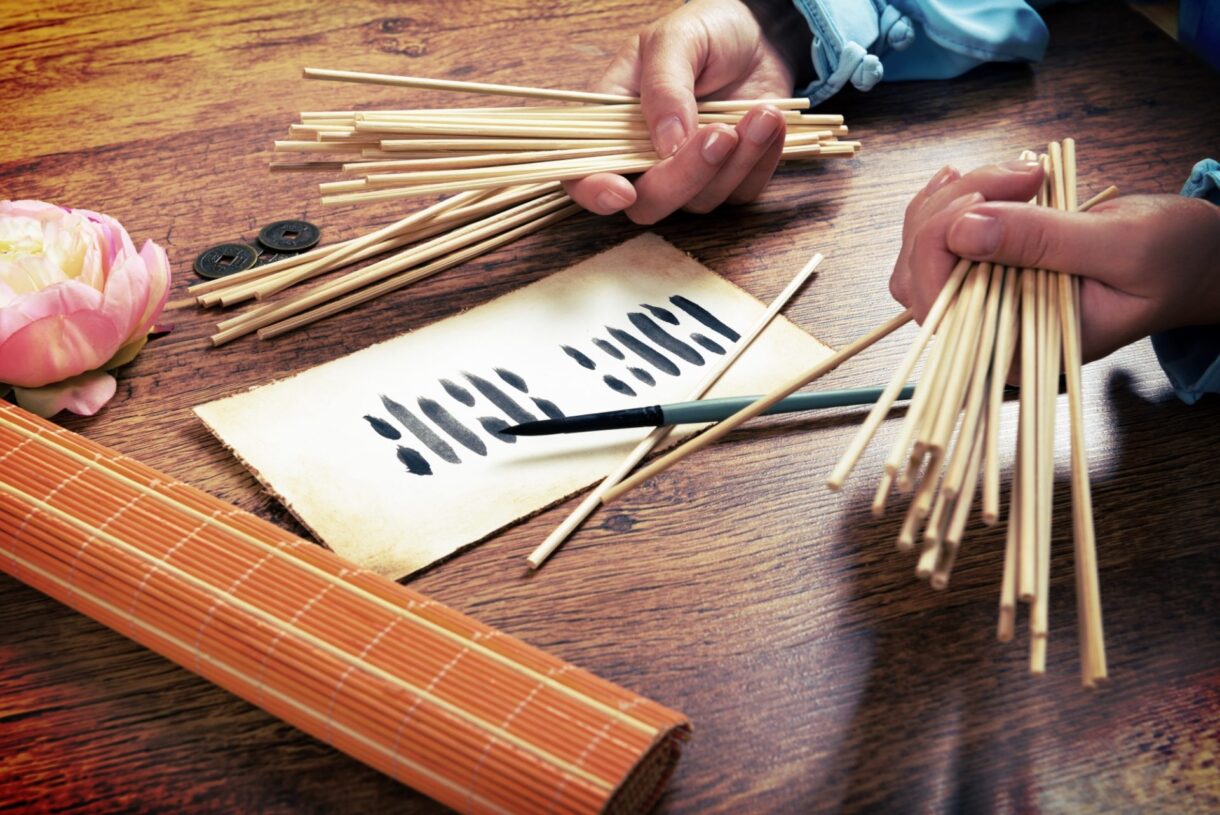The I Ching (Yi Jing) is most commonly referred to as the Book of Changes / Book of Wisdom and is an integral part of divination and fortuitous readings.
If we look at the words themselves, we have:
- I / Yi – means to change
- Ching / Jing – means book, or ‘in the old days’
Whether you say I Ching, or Yi Jing, it’s the same thing.
The I Ching has strong connections to both the Shang dynasty and the Zhou dynasty, making it an important aspect of Chinese culture.
According to Chinese mythology, Fu Xi, one of the three sovereigns of ancient China, is believed to have created the eight trigrams which serve as the basis for the I Ching.
What is The I Ching?
The I Ching is an ancient Chinese divination system and philosophical text, also known as the Book of Changes, as it is a representation of the ever-changing nature of the universe.
The I Ching consists of 64 hexagrams, each made up of six broken or unbroken lines that can be interpreted to reveal guidance, wisdom, and insight into various aspects of life.
Based on the principles of balance, harmony, and the interconnectedness of all things, the I Ching is used as a tool for self-reflection, decision-making, and understanding the cyclical nature of existence
I Ching Philosophy
The I Ching philosophy is based on the concept of change and the interconnectedness of all things.
It offers insights and advice on how to achieve balance, harmony, and personal growth.
The I Ching is founded on the principles of balance and change, recognizing the interconnectedness of all things.
This philosophy is deeply rooted in Chinese culture and has influenced various aspects of life – from spirituality and art to medicine and governance.
It is believed to have been written over 3,000 years ago and is considered one of the oldest and most profound sources of wisdom in Chinese culture.
What Are The Principles of The I Ching?
1. The principle of balance:
The I Ching emphasizes the importance of maintaining balance and harmony in all aspects of life. This includes balancing our physical, emotional, mental, and spiritual aspects to achieve overall well-being.
2. The principle of change:
The I Ching is based on the belief that everything in the universe is constantly changing and evolving. It teaches us to embrace change and adapt to the ever-changing nature of life.
3. The principle of interconnectedness:
According to the I Ching, everything in the universe is interconnected and we are all part of a larger whole. This principle encourages us to consider the effects of our actions on others and the world around us.
4. The principle of harmony:
The I Ching emphasizes the importance of cultivating inner harmony and alignment with the natural flow of the universe. When we are in harmony with ourselves and the world, we can achieve inner peace and fulfillment.
5. The principle of yin and yang:
The concept of yin and yang, symbolized by the Tai Chi symbol, is central to the I Ching. It represents the balance between opposing forces and the constant interplay between them. This principle teaches us to embrace the duality of life and find balance between opposing energies.
6. The principle of cycles:
The I Ching recognizes that everything in life occurs in cycles and that change is inevitable. By understanding the cyclical nature of life, we can better prepare for and navigate through life’s challenges and opportunities.
7. The principle of self-empowerment:
The I Ching emphasizes the power of personal responsibility and encourages us to take charge of our own lives. It teaches us that our actions and intentions have a direct impact on our experiences and outcomes.
8. The principle of self-reflection:
The I Ching teaches us to look within ourselves for answers and guidance. It encourages self-reflection and introspection as a means of gaining insight, wisdom, and self-awareness.
9. The principle of acceptance:
The I Ching teaches us to accept things as they are, without trying to control or change them. By accepting the present moment and its lessons, we can find inner peace and contentment.
10. The principle of unity:
The ultimate goal of the I Ching is to achieve unity with the universe and all beings. This principle emphasizes the interconnectedness of all things and encourages us to strive for greater understanding, compassion, and oneness with all.
What Are The Hexagrams Of The I Ching?
The I Ching book consists of 64 hexagrams. A hexagram in this context is a figure composed of six stacked horizontal lines (爻 yáo), where each line is either Yang (an unbroken, or solid line), or Yin (broken, an open line with a gap in the center)
Each I Ching hexagram is made up of two trigrams, the upper and the lower, and each trigram is assigned one of the eight elements repeated for the upper and lower trigrams.
The eight elements are: Heaven, Earth, Thunder, Water, Mountain, Wind, Fire, and Lake
How To Use The I Ching
1. Gather the necessary materials.
To consult the I Ching, you will need either a traditional set of 50 yarrow stalks or three coins (preferably coins with different symbols on each side). You will also need a copy of the I Ching book, or access to an online version.
2. Prepare yourself.
Before using the I Ching, it is important to be in a calm and meditative state. Take a few deep breaths and clear your mind of any distractions or worries. This will allow you to receive a clear and meaningful answer from the I Ching.
3. Formulate your question.
The I Ching is intended to provide guidance and insight, so it is important to ask a clear and specific question. Avoid yes or no questions, as the I Ching is not meant to predict the future but rather provide guidance for the present moment.
4. Using yarrow stalks:
Hold the yarrow stalks in your hand and think about your question. Then, shake the stalks, allowing a few to fall to the ground. Count the remaining stalks in your hand, which should be either 3, 4, or 5. Record this number and repeat the process six times, creating a six-line symbol called a hexagram.
4. Using coins:
Hold the coins in your hand and think about your question. Assign one side of the coin as “heads” and one side as “tails.” Toss the coins six times, recording the number of heads and tails each time. This will create a six-line binary pattern, which can be converted into a hexagram.
5. Find the corresponding hexagram:
To find the symbol that corresponds with your hexagram, use a copy of the I Ching book or an online version. Locate the hexagram that matches your pattern and read the accompanying text for insight and guidance.
6. Interpret the answer:
The I Ching is considered a complex, multilayered system of divination, so it may take some time to fully understand the meaning of your hexagram. Read and reflect on the text, and consider seeking further guidance or clarification from a trained I Ching practitioner.
7. Use changing lines (optional):
In addition to the main hexagram, the I Ching also has “changing lines” that can modify the meaning of the hexagram. If you have any changing lines from your original hexagram, they will be indicated in the text and you can read their corresponding meaning.
8. Consider the overall message:
It is important to look at the entire hexagram, including both the main hexagram and any changing lines, to understand the overall message and guidance from the I Ching. This may include both positive and negative aspects, and can offer valuable insight into your current situation.
9. Repeat as needed:
The I Ching can provide guidance for any question or situation, so you can continue using it anytime you need advice or guidance. Keep an open mind and use the wisdom of the I Ching to navigate through life’s challenges.
Can You Use an I Ching App?
Yes, you can use an I Ching app on your smartphone or device. Many apps are available for download from app stores and can be used to generate hexagrams and readings of the I Ching.
These apps often include additional features, such as interpretations and commentaries on the hexagrams, as well as the ability to input your own questions and save your readings for future reference.
It is important to research and choose a reputable app from a trusted source to ensure accuracy and authenticity in your readings.
You know me, I’m gonna say it how it is…
If you want to tap into the Universe for eternal guidance that is the wisest and most thought-provoking advice you can ever recieve… you need to do it the old fashioned way.
One person to one Universe.







